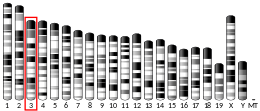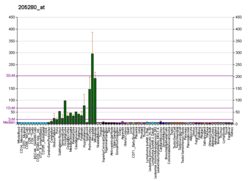GLRB
Glycine receptor subunit beta is a protein that in humans is encoded by the GLRB gene.[5][6][7]
The inhibitory glycine receptor mediates postsynaptic inhibition in the spinal cord and other regions of the central nervous system. It is a pentameric receptor composed of alpha (GLRA1, MIM 138491; GLRA2, MIM 305990) and beta subunits.[supplied by OMIM][7]
See also
References
- GRCh38: Ensembl release 89: ENSG00000109738 - Ensembl, May 2017
- GRCm38: Ensembl release 89: ENSMUSG00000028020 - Ensembl, May 2017
- "Human PubMed Reference:". National Center for Biotechnology Information, U.S. National Library of Medicine.
- "Mouse PubMed Reference:". National Center for Biotechnology Information, U.S. National Library of Medicine.
- Milani N, Mulhardt C, Weber RG, Lichter P, Kioschis P, Poustka A, Becker CM (Oct 1998). "The human glycine receptor beta subunit gene (GLRB): structure, refined chromosomal localization, and population polymorphism". Genomics. 50 (3): 341–5. doi:10.1006/geno.1998.5324. PMID 9676428.
- Handford CA, Lynch JW, Baker E, Webb GC, Ford JH, Sutherland GR, Schofield PR (Oct 1996). "The human glycine receptor beta subunit: primary structure, functional characterisation and chromosomal localisation of the human and murine genes". Brain Res Mol Brain Res. 35 (1–2): 211–9. doi:10.1016/0169-328x(95)00218-h. PMID 8717357.
- "Entrez Gene: GLRB glycine receptor, beta".
Further reading
- Meyer G, Kirsch J, Betz H, Langosch D (1995). "Identification of a gephyrin binding motif on the glycine receptor beta subunit". Neuron. 15 (3): 563–72. doi:10.1016/0896-6273(95)90145-0. PMID 7546736.
- Sarang SS, Miller GW, Grant DF, Schnellmann RG (1999). "Expression and localization of the neuronal glycine receptor beta-subunit in human, rabbit and rat kidneys". Nephron. 82 (3): 254–60. doi:10.1159/000045410. PMID 10395998.
- Rees MI, Lewis TM, Kwok JB, et al. (2002). "Hyperekplexia associated with compound heterozygote mutations in the beta-subunit of the human inhibitory glycine receptor (GLRB)". Hum. Mol. Genet. 11 (7): 853–60. doi:10.1093/hmg/11.7.853. PMID 11929858.
- Strausberg RL, Feingold EA, Grouse LH, et al. (2003). "Generation and initial analysis of more than 15,000 full-length human and mouse cDNA sequences". Proc. Natl. Acad. Sci. U.S.A. 99 (26): 16899–903. doi:10.1073/pnas.242603899. PMC 139241. PMID 12477932.
- Chen Z, Dillon GH, Huang R (2004). "Molecular determinants of proton modulation of glycine receptors". J. Biol. Chem. 279 (2): 876–83. doi:10.1074/jbc.M307684200. PMID 14563849.
- Burzomato V, Groot-Kormelink PJ, Sivilotti LG, Beato M (2004). "Stoichiometry of recombinant heteromeric glycine receptors revealed by a pore-lining region point mutation". Recept. Channels. 9 (6): 353–61. doi:10.3109/714041016. PMID 14698963.
- Harvey K, Duguid IC, Alldred MJ, et al. (2004). "The GDP-GTP exchange factor collybistin: an essential determinant of neuronal gephyrin clustering" (PDF). J. Neurosci. 24 (25): 5816–26. doi:10.1523/JNEUROSCI.1184-04.2004. PMID 15215304.
- Grudzinska J, Schemm R, Haeger S, et al. (2005). "The beta subunit determines the ligand binding properties of synaptic glycine receptors". Neuron. 45 (5): 727–39. doi:10.1016/j.neuron.2005.01.028. PMID 15748848.
External links
- GLRB+protein,+human at the US National Library of Medicine Medical Subject Headings (MeSH)
This article incorporates text from the United States National Library of Medicine, which is in the public domain.
This article is issued from Wikipedia. The text is licensed under Creative Commons - Attribution - Sharealike. Additional terms may apply for the media files.







